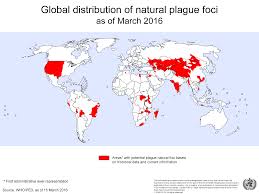Echoes of the Past: What is Pneumonic Plague?
Pneumonic plague, a severe form of the bacterium Yersinia pestis, has been a source of terror throughout history, synonymous with the Black Death that decimated Europe in the 14th century. Unlike bubonic plague, which primarily spreads through flea bites, pneumonic plague can be transmitted directly from person to person through respiratory droplets, making it particularly alarming in densely populated areas.
A Current Perspective on Pneumonic Plague
The World Health Organization (WHO) has emphasized that while pneumonic plague remains rare, it persists in certain regions of the world including parts of Africa, Asia, and the Americas. Recent statistics show that although cases have plummeted compared to historical times, around 3,000 cases are reported globally each year, primarily in rural areas where the disease is endemic. Public health awareness is crucial in these regions, as symptoms can escalate rapidly, leading to severe respiratory issues, pneumonia, and even death if left untreated.
Public Concern and Social Media Sentiment
In recent months, reports of isolated pneumonic plague cases have resurfaced, largely due to heightened media coverage around infectious diseases. Social media platforms, often rife with both valid concerns and misinformation, have witnessed a surge of dialogue surrounding the disease. Tweets and posts reflect a mix of fear and curiosity, with many people urging for more transparency from health officials.
Public forums have seen activists calling for increased funding for research and health education programs. Lisa Morrow, a global health advocate, stated, “We must not forget the lessons of the past. Pneumonic plague is a stark example of how neglect can lead to severe outbreaks, and we need to prioritize education and resources to mitigate this risk.” Her statement underscores the urgency of vigilance in public health.
Expert Opinions on Containment and Treatment
Experts agree that the key to managing pneumonic plague lies in early detection and timely antibiotic treatment. Dr. Harrison Lee, an epidemiologist specializing in infectious diseases, remarks, “With swift identification, the treatment for pneumonic plague is highly effective. However, the challenge remains in ensuring that healthcare systems are equipped to recognize symptoms and respond appropriately, especially in remote areas with fewer resources.”
Health authorities are increasingly focused on preventative measures, including vaccinating at-risk populations. Additionally, they stress the importance of educating communities about recognizing early symptoms such as sudden onset of fever, weakness, and severe respiratory distress.
Looking Ahead: A Contained Threat?
The challenge that pneumonic plague poses today is much different from previous centuries. Advances in modern medicine and public health strategies can mitigate the risks it presents. However, the potential for outbreak remains, especially in regions that have experienced health crises due to other infectious diseases.
Ultimately, while pneumonic plague may have receded into the shadows of history, ongoing vigilance is crucial. The global health community must remain prepared to respond not just to current infectious threats but also to those lingering legacies of the past that could re-emerge at any moment.
